A Health Trust has contracted with Servitup, a catering services organisation which has been certified to ISO 9001 for 1 year. It provides services to ten, small rural
hospitals in remote locations involving purchase and storage of dry goods and fresh produce, preparing meals and loading heated trolleys for ward service by hospital
staff. An auditor is conducting the first sole surveillance audit at one site with the Deputy Catering Manager (DCM).
At the closing meeting attended solely by the DCM, the auditor informs him that he has found numerous gaps in the QMS processes which lead him to consider
recommending suspension of the organisation's certification. He is particularly concerned with the evidence that patient health is being adversely affected by produce
stored beyond its safe consumption date, poor kitchen hygiene and undercooked meals. The DCM says that he cannot make any decisions about these issues in the
absence of the Catering Manager due to illness but will write everything down and report to the Catering Manager.
Which two actions should you take in the context of the audit?
During the opening meeting of a third-party audit of a pharmaceutical organisation (CD9000) with seven COVID-19 testing laboratories in various terminals at a major international airport, you are asked if you could
visit all laboratories. As audit team leader you say that, based on sampling criteria, you had planned to audit only three of them as CD9000 is a multisite organisation.
They tell you that they have worked so hard to get ready for the audit that the supervisors of those laboratories that would not be visited would be quite disappointed.
The following are possible responses to the request, select the two best responses:
What is a list of actions that should be performed during the audit with their respective timeline?
Select one of the options that best describes the purpose of conducting a document review:
XYZ Corporation is an organisation that employs 100 people. As audit team leader, you are conducting a
certification audit at Stage 1. When reviewing the quality management system (QMS) documentation, you
find that quality objectives have been set for every employee in the organisation except top management.
The Quality Manager complains that this has created a lot of resistance to the QMS, and the Chief Executive
is asking questions about how much it will cost. He asks for your opinion on whether this is the correct
method of setting objectives.
Three months after Stage 1, you return to XYZ Corporation to conduct a Stage 2 certification audit as Audit
Team Leader with one other auditor. You find that the Quality Manager has cancelled the previous quality
objectives for all employees and replaced them with a single objective for himself. This states that "The
Quality Manager will drive multiple improvements in the QMS in the next year". The Quality Manager indicates
that this gives him the authority to issue instructions to department managers when quality improvement is
needed. He says that this approach has the full backing of senior management. He shows you the latest
Quality Improvement Request that was included in the last management review.
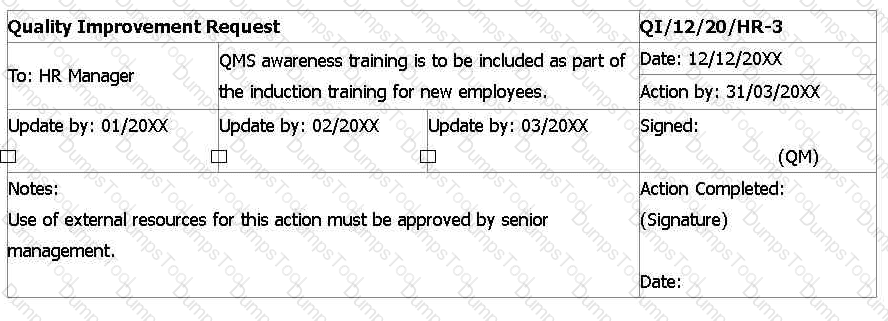
After further auditing, the issues below were found. Select three statements that apply to the term 'audit trail'
Which statement below indicates that an organization has developed its communication strategy by taking into account the principle of appropriateness?
Which statement regarding the drafting of the audit conclusions is correct?
You are an auditor from a construction organisation who is conducting a second party audit to ISO 9001 at a steel rolling mill producing
structural steelwork. When auditing the rolling process, you find that the operator who is unloading the furnace does not use the
adjacent infrared pyrometer to measure the appropriate product temperature in readiness for the next production stage.
You: "How do you tell when the billet is ready for the rolling stage?"
Operator: "I've done this job for 20 years. I can tell by the bright red colour."
You: "What happens if the colour is wrong?"
Operator: "The billet goes back into the furnace."
You: "Is the pyrometer ever used?"
Operator: "Only in borderline cases."
You continue to interview the operator and find that around 25% of the billets are sent back to the furnace. This includes 80% of the borderline cases.
Select three options that would provide evidence of conformance with clause 9.1.1 of ISO 9001.
Whistiekleen is a national dry cleaning and laundry organisation with 50 shops. You are conducting a surveillance audit of the Head Office and are sampling customer complaints. You find that 80% of complaints originate from five shops in the same region. Most of these complaints relate to damage to customer laundry. The Quality Manager tells you that these are the oldest shops in the organisation. The deaning equipment needs replacing but the organisation cannot afford it now. You learn that the shop managers were told to dismiss most of the claims based on the poor quality of the laundered materials.
On raising the matter with senior management, you are told that there are plans to replace the equipment in these shops over the next five years.
Match the ISO 9001 Clauses to the statements.
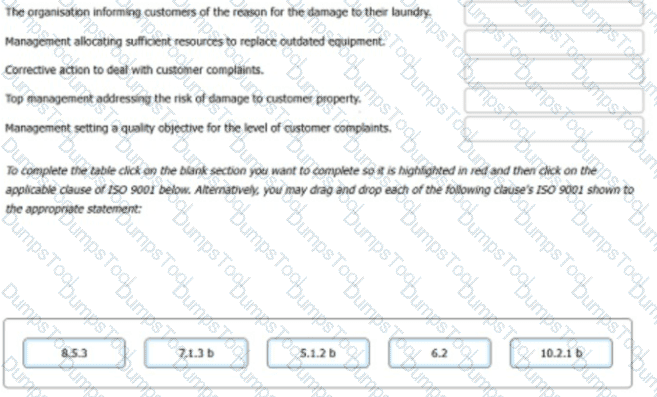
You are leading a Stage 2 certification audit of a multi-site organisation and have received the audit schedule below;
Head Office and Site 1 - Day 1
Site 2 (150 Km from HQ) - Days 2 and 3
During Day 1 of the audit, the dient informs you that the laboratory at Site 2 has been dosed for decontamination due to a serious outbreak of an infectious disease among workers. In Site 2, all other functions could be audited as planned.
As the audit team leader, what would you do?
Choose the best acceptable action you could take:
® Ask the audit Programme Manager for direction.
Complete the audit on day 3 and report back to the certification body for a certification decision.
Continue the audit on days 2 and 3 and return later to audit the Site 2 laboratory.
Immediately cancel the audit since the audit plan cannot be completed.
Who has the responsibility for assigning work to the audit team?
You are carrying out an annual audit at an organisation that offers home security services. You are interviewing the Quality Manager (QM)
You: "Would you tell me about your management review process?"
QM: "The senior management team plans to review the management system every six months. The review follows a set agenda and records are maintained."
You: "May I see the records from the last two management reviews?"
Narrative: The Quality Manager gives you the latest record, which shows the last management review took place nine months ago.
The Quality Manager then gives you the previous management review record, which took place one year before the latest review.
You: "Are there any other review reports in the last two years?
QM: "No, these are the only ones."
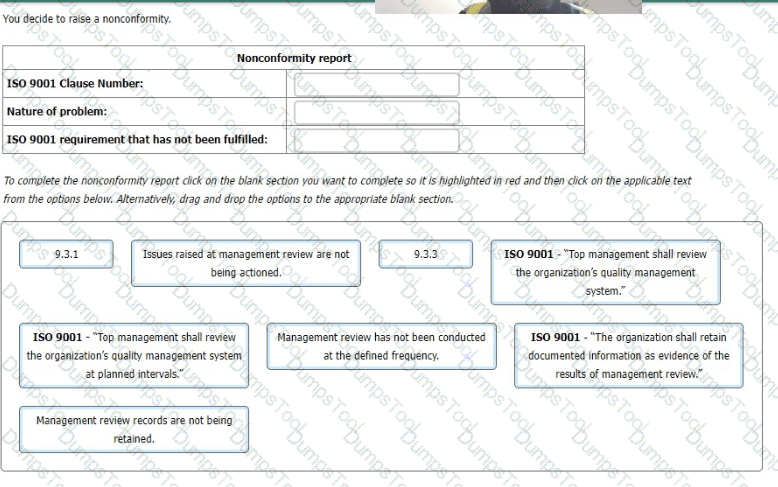
You work for an organisation, 'ABC', which provides packaged food to the public. You are asked to lead a team (you as the leader and two other
auditors) to audit an external provider, 'XYZ', which provides packaging materials to your organisation. It is 4 pm, and the audit is dlose to an end;
you are having an internal meeting with the team to decide what will be presented to the auditee during the Closing meeting. The Closing meeting
was scheduled for 5 pm.
'XYZ' has two manufacturing lines: M1 is a clean room for primary packaging materials (i.e. will be in direct contact with the food), and M2 is for
secondary materials (i.e. will not be in direct contact with food).
Auditor 1 audited the two manufacturing lines.
You: "What findings would you report?"
Auditor 1: "I have one issue. Earlier today in the morning I saw some secondary material stocked in the clean room. I would propose raising a
nonconformity."
You: "How would you write the nonconformity?"
Auditor 1: "In the clean room, there was a pallet with secondary materials."
What additional information would you add to this text to complete the nonconformity report? Select six.
Which one of the following options is the definition of the context of an organisation?
Whistlekleen is a national dry cleaning and laundry company with 50 shops. You are conducting a surveillance audit of the Head Office and are sampling customer complaints. 80% of complaints originate from five shops in the same region. Most of these complaints
relate to customer laundry not being cleaned as customers require. The Quality Manager tells you that these are the oldest shops in the company. The cleaning equipment needs replacing but the company cannot afford it now. You learn that the shop managers were
told to dismiss most of the complaints because of the poor quality of the laundered materials.
On raising the matter with senior management, you are told that there are plans to replace the equipment in these shops over the next five years.
You raised a nonconformity against clause 8.5.1 of ISO 9001.
Based on the scenario, select the three options which best describe the evidence for raising such a nonconformity.
Audit criteria are a set of requirements used as a reference against which objective evidence is compared.
Which two of the following are not potential audit criteria?
Below are four of the seven principles on which ISO 9000 series are based. Match a potential benefit to each of the quality management principles (QMP).
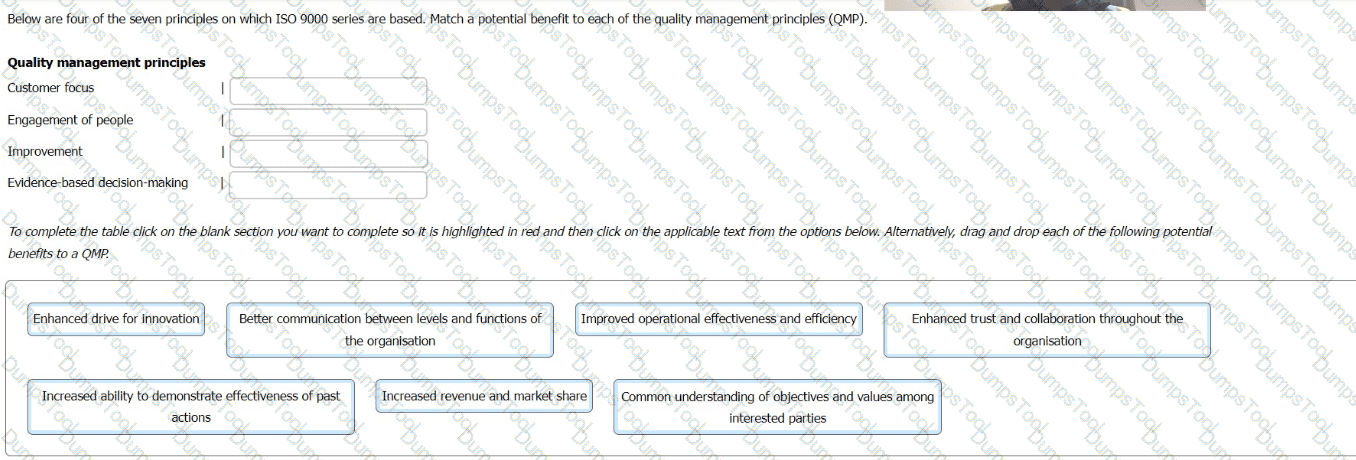
Whistlekleen is a national dry cleaning and laundry company with 50 shops. You are conducting a surveillance audit of the Head Office and are sampling customer complaints. You find that 80% of complaints originate from five shops in the same region. Most of these complaints relate to damage to customer laundry. The Quality Manager tells you that these are the oldest shops in the company. The cleaning equipment needs replacing but the company cannot afford it at the moment. You learn
that the shop managers were told to dismiss most of the claims on the basis of the poor quality of the laundered materials.
On raising the matter with senior management, you are told that there are plans to replace the equipment in these shops over the next five years.
When reviewing the customer complaint file, you find that the organisation is facing a legal dispute with a customer over damage to an expensive cashmere coat.
Select the best option for how this should be handled by the Quality Management System.
You are conducting an ISO 9001 audit of a Materials Recycling Facility (MRF). The company
processes waste plastics into raw material for plastic bottle manufacturers. You reach the manual
picking line where operators are removing contaminant materials from incoming products, such as
plastic bags, plastic film and badly contaminated items that would compromise the recycling process.
You interview the line supervisor.
You: "Why are these plastic items being rejected at this stage?"
Auditee: "They do not meet our processing standards."
You: "What is the reason for that?"
Auditee: "These items are likely to damage the machinery down the line. They can also
compromise our quality standards. We need to protect our reputation for good quality output
materials."
You: "What happens to the rejected items?"
Auditee: "Some get melted down in another process later on and some are disposed of as waste
products that cannot be recycled."
You: "What happens to the waste products?"
Auditee: "I'm not sure. I suppose they go to landfill."
After further auditing, you have gathered additional evidence.
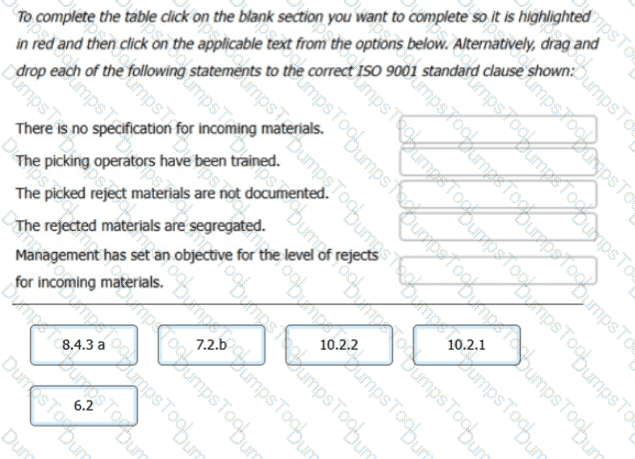
At the end of a second-party audit, the audit team enters the meeting room to hold the closing meeting; only two people
are present and waiting for them: the Health and Safety supervisor and the administrative officer. Neither has participated in
the audit. However, the team had previously agreed with the auditee Quality Manager on two nonconformities identified
during the audit (NC1 and NC2).
They said:
Health and Safety supervisor: "Good evening. We are sorry to inform you that the general manager was involved in a
serious car accident, and the other two managers have had to leave urgently to attend to the emergency."
Administration officer: "Our quality manager, before leaving, left a written message about 'NC2'. He declares that the
correction and corrective action have been already implemented and has attached some documents to the message as
evidence of these actions. Therefore, he expects that 'NC2' will not be included in the report."
Which one of the following would be your preferred answer to the Quallty Manager's request?
You are carrying out an audit at an organisation seeking certification to ISO 9001 for the first time. The organisation offers health and safety training to customers. Training courses are offered either as open courses, delivered at a public venue, or online, or as courses that are tailored to meet specific requirements. The business operates from a single office and those who deliver the training are either full-time employees or subcontractors.
You are interviewing the Training Manager (TM).
You: "What quality objectives apply to the training process?"
TM: "One of the quality objectives we aim for is a 90% minimum exam pass rate for all open training courses."
You: "How do you measure this objective?"
The Training Manager shows you a record on her computer and you see the following:
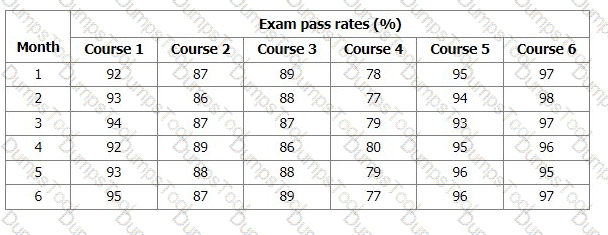
Which two of the following statements are true?
XYZ Corporation is an organisation that employs 100 people. As audit team leader, you are conducting a
certification audit at Stage 1. When reviewing the quality management system (QMS) documentation, you
find that quality objectives have been set for every employee in the organisation except top management.
The Quality Manager complains that this has created a lot of resistance to the QMS, and the Chief Executive
is asking questions about how much it will cost. He asks for your opinion on whether this is the correct
method of setting objectives.
Three months after Stage 1, you return to XYZ Corporation to conduct a Stage 2 certification audit as Audit
Team Leader with one other auditor. You find that the Quality Manager has cancelled the previous quality
objectives for all employees and replaced them with a single objective for himself. This states that "The
Quality Manager will drive multiple improvements in the QMS in the next year". The Quality Manager indicates
that this gives him the authority to issue instructions to department managers when quality improvement is
needed. He says that this approach has the full backing of senior management. He shows you the latest
Quality Improvement Request that was included in the last management review.
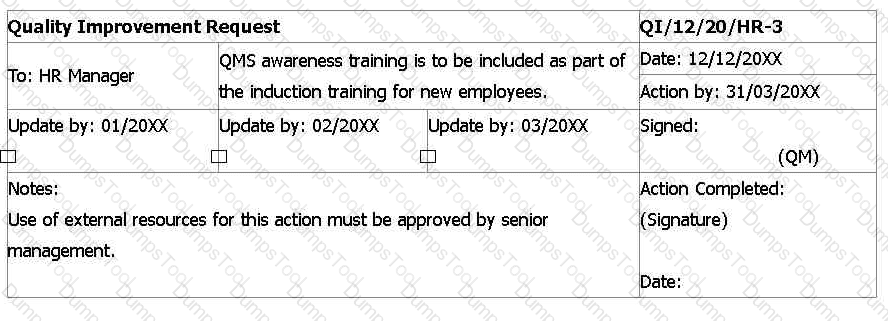
After further auditing, the issues below were found. Select two statements that apply to the term
`nonconformity'.
Scenario 1: AL-TAX is a company located in California which provides financial and accounting services. The company manages the finances of 17 companies and now is seeking to expand their business even more The CEO of AL-TAX, Liam Durham, claims that the company seeks to provide top-notch services to their clients Recently, there were a number of new companies interested in the services provided by AL-TAX.
In order to fulfill the requirements of new clients and further improve quality, Liam discussed with other top management members the idea of implementing a quality management system (QMS) based on ISO 9001. During the discussion, one of the members of the top management claimed that the size of the company was not large enough to implement a QMS. In addition, another member claimed that a QMS is not applicable for the industry in which AL TAX operates. However, as the majority of the members voted for implementing the QMS. Liam initiated the project.
Initially, Liam hired an experienced consultant to help AL-TAX with the implementation of the QMS. They started by planning and developing processes and methods for the establishment of a QMS based on ISO 9001. Furthermore, they ensured that the quality policy is appropriate to the purpose and context of AL TAX and communicated to all employees. In addition, they also tried to follow a process that enables the company to ensure that its processes are adequately resourced and managed, and that improvement opportunities are determined.
During the implementation process, Liam and the consultant focused on determining the factors that could hinder their processes from achieving the planned results and implemented some preventive actions in order to avoid potential nonconformities Six months after the implementation of the QMS. AL-TAX conducted an internal audit. The results of the internal audit revealed that the QMS was not fulfilling all requirements of ISO 9001. A serious issue was that the QMS was not fulfilling the requirements of clause 5.1.2 Customer focus and had also not ensured clear and open communication channels with suppliers.
Throughout the next three years, the company worked on improving its QMS through the PDCA cycle in the respective areas. To assess the effectiveness of the intended actions while causing minimal disruptions, they tested changes that need to be made on a smaller scale. After taking necessary actions, AL-TAX decided to apply for certification against ISO 9001.
Based on the scenario above, answer the following question:
Scenario 1 indicates that AL-TAX did not ensure clear and open communication channels with interested parties. Which quality management principle did the organization not follow in this case?
Which two of the following work documents are not required for audit planning by an auditor conducting a certification audit?
Noitol is an organisation specialising in the design and production of e-learning training materials for the insurance market. During an ISO 9001 audit
of the development department, the auditor asks the Head of Development about the process used for validation of the final course design. She states that they usually ask customers to validate the product with volunteers. She says that the feedback received often leads to key improvements.
The auditor samples the design records for a recently completed course for the 247 Insurance organisation. Design verification was carried out but there was no validation report. The Head of Development advises that this customer required the product on an urgent basis, so the validation stage
was omitted. When asked, the Head estimates that this occurs about 50% of the time. She confirms that they always ask for feedback and often make changes. There is no record of feedback in the design file for the course.
The auditor raises a nonconformity against ISO 9001. Which one of the following options is the basis for the nonconformity?
Whistlekleen is a national dry cleaning and laundry company with 50 shops. You are conducting a surveillance audit of the Head Office and are sampling customer
complaints. You find that 80% of complaints originate from five shops in the same region. Most of these complaints relate to damage to customer laundry. The Quality
Manager tells you that these are the oldest shops in the company. The cleaning equipment needs replacing but the company cannot afford it at the moment. You learn
that the shop managers were told to dismiss most of the claims on the basis of the poor quality of the laundered materials.
On raising the matter with senior management, you are told that there are plans to replace the equipment in these shops over the next five years.
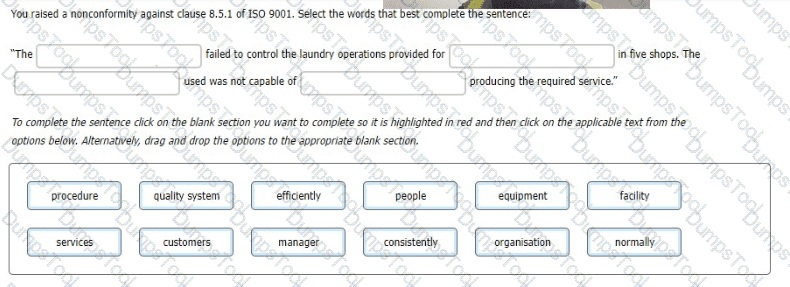
Which two of the following auditors would not participate in a first-party audit?
Which one of the following documents addresses audit time calculation for third-party certification audits?
An organization has decided to implement a QMS based on ISO 9001. What should they consider when determining internal issues?
TIX provides services to the informatic equipment of large organisations. They operate an ISO 9001:2015 QMS that is being audited by an important
customer (second-party audit). During the audit, the audit team has identified two nonconformities. When preparing the Closing meeting, the audit
team discussed and agreed both nonconformities with TIX's quality manager. The Closing meeting was planned for 6pm with the general manager,
quality manager and service manager at the meeting room.
At 6pm, when the audit team enters the meeting room, only two people are present and waiting for them: the Health and Safety supervisor and the
warehouse supervisor. Neither have participated in the audit.
The dialogue among them is as follows:
Audit team leader: "Good evening, could you please inform the three managers that we are ready to start with the Closing meeting?"
Health and Safety supervisor: "Good evening. We are sorry to inform you that the general manager was involved in a serious car accident, and
the other two managers have had to leave urgently to attend the emergency."
Warehouse supervisor: "They have asked us to listen to what you need to say and to sign whatever we need to sign. We also have a message
from them about the two nonconformities. They wanted us to ask you if you could contact them in a couple of days to determine how to proceed."
Which one of the following options would be your preferred response to the final comment made by the warehouse manager?
The following list gives examples of records that may be evidence of how an organisation has fulfilled the requirements of clause 8.4 of ISO 9001. Match the records to the appropriate requirement of clause 8.4.

The Closing meeting of a second-party audit was planned for 6 pm with the general manager and the quality manager.
At 6 pm, when the audit team enters the meeting room, only the Quality Manager is present and walting for them.
The dialogue among them is as follows:
Auditor team leader: "Good evening, could you please inform the general manager that we are ready to start with the closing meeting?"
Quality manager: "Good evening. I am sorry to inform you that the general manager will not be able to attend the meeting. He will try to
participate virtually to make some closing remarks."
Auditor team leader: "OK. We identified seven nonconformities - these are the reports. Could you please review them and sign them?"
Quality manager: "OK. As you know, I reviewed them after yesterday's meeting and accept of all them, where shall I sign?"
General manager (from speakers in the room and addressing the quality manager): "Hold on! Do not sign the two nonconformities related to ABC
Bank! I have just checked, and we did not provide any services to ABC Bank during September! You can sign the remaining five nonconformities."
How would you proceed with the audit? Select one.
Scenario 6: Davis Clinic (DC) is an American medical center focused on integrated health care. Since its establishment DC was committed to providing qualitative services for its clients, which is the reason why the company decided to implement a quality management system (QMS) based on ISO 9001. After a year of having an active QMS in place, DC applied for a certification audit.
A team of five auditors, from a well-known certification body, was selected to conduct the audit. Eva was appointed as the audit team leader. After three days of auditing, the team gathered to review and examine their findings. They also discussed the audit findings with DC's top management and then drafted the audit conclusions.
In the closing meeting, which was held between the audit team and the top management of DC. Eva presented two nonconformities that were detected during the audit. Eva stated that the company did not retain documented information regarding its outsourced services for an analysis laboratory and regarding the conducted management reviews. During the closing meeting, the audit team required from DCs top management to come up with corrective action plans within two weeks. Although the top management did not agree with the audit findings, the audit team insisted that the auditee must submit corrective actions within the given time frame in order for the audit activities to continue.
Once the action plans were evaluated, the audit team began preparing the audit report. Eva required from the team to provide accurate descriptions of the audit findings and the audit conclusions. The report was then distributed to all the interested parties involved in the audit, including the certification body Based on the report, the certification body together with Eva, as the audit team leader, made the certification decision.
Based on the scenario above, answer the following question:
According to Scenario 6, the audit team required DC’s top management to submit corrective action plans within two weeks. Is this action acceptable?
State the correct sequence of events in the certification process for an organisation to obtain third-party accredited certification to ISO 9001.
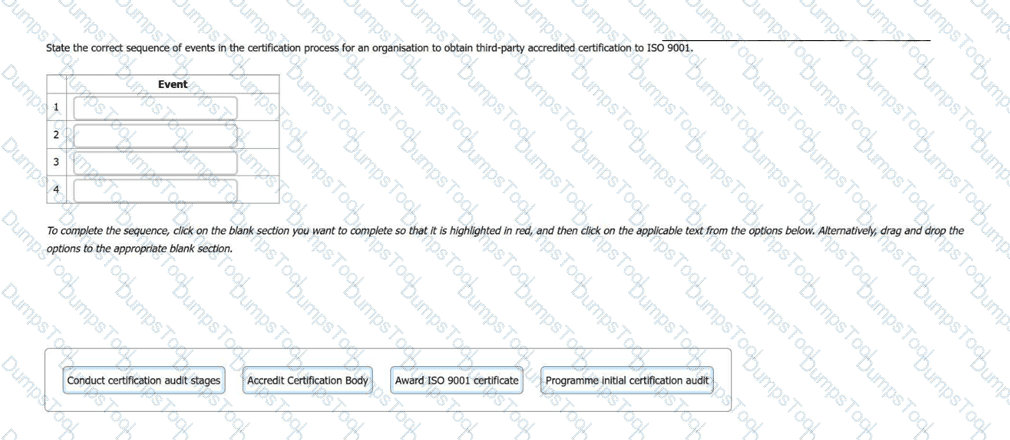
You are conducting a third-party Stage 1 audit at ABC Ltd, a single-site organisation that manufactures wooden furniture. You interview the Technical Director to learn more about the organisation. The Technical Director explains that they have had a successful year and that obtaining ISO 9001 certification will support the further growth of the business. You ask for an overview of the organisation's structure and its interrelationships with external interested parties.
The Technical Director shows you a document detailing all business processes and interrelationships. You notice in this document that another organisation called Teak Ltd manufactures wooden furniture on behalf of ABC Ltd. The Technical Director confirms this capability has been accounted for in the scope of the quality management system. You learn that the furniture manufactured by Teak Ltd has accounted for 40% of the sales revenue over the previous 12 months.
Which two of the following options best describe how you would plan the audit of the interrelationship with Teak Ltd during the Stage 2 audit at ABC Ltd?
Scenario 4:
TD Advertising is a print management company based in Chicago. The company offers design services, digital printing, storage, and distribution. As TD expanded, its management recognized that success depended on adopting new technologies and improving quality.
To ensure customer satisfaction and quality improvement, the company decided to pursue ISO 9001 certification.
After implementing the QMS, TD hired a well-known certification body for an audit. Anne Key was appointed as the audit team leader. She received a document listing the audit team members, audit scope, criteria, duration, and audit engagement limits.
Anne reviewed the document and approved the audit mandate. The certification body and TD’s top management signed the certification agreement.
Before contacting TD, Anne reviewed the audit scope and noticed that TD made changes to it due to the adoption of new printing equipment. However, Anne disagreed with the changes, stating they would affect the audit timeline. She considered withdrawing from the audit.
In scenario 4, the audit team determined the audit feasibility by considering only the resources available for the audit. Is this acceptable?
You are conducting a third-party audit to ISO 9001 and interviewing the Training Manager. She explains that training is more
important than ever because the organisation has had to reduce the number of staff employed. Many of the remaining staff
are now required to be 'multi-skilled'. You ask to see plans for the multi-skilling training and are shown plans that look
comprehensive, and include both 'on the job" training and internal and external training courses.
The records indicate that several staff required parts of their training to be repeated one month after the first training was
provided. You ask why this was needed and are told that an investigation of customer complaints identified that several staff
members did not complete certain tasks in the correct manner. The extra training was therefore recommended as a
corrective action.
Based on this interview, which two of the tollowing audit trails would be the most appropriate to follow?
Select the two most appropriate audit trails from the following.
Even though past audits have highlighted a consistently large number of nonconformities within an organisation's design team, the organisation has not varied the frequency or duration of audits on its audit plan.
The decision for whether this situation is acceptable or not should be governed by which of the following?
The following are stages of an audit, put them in the order they would be conducted.
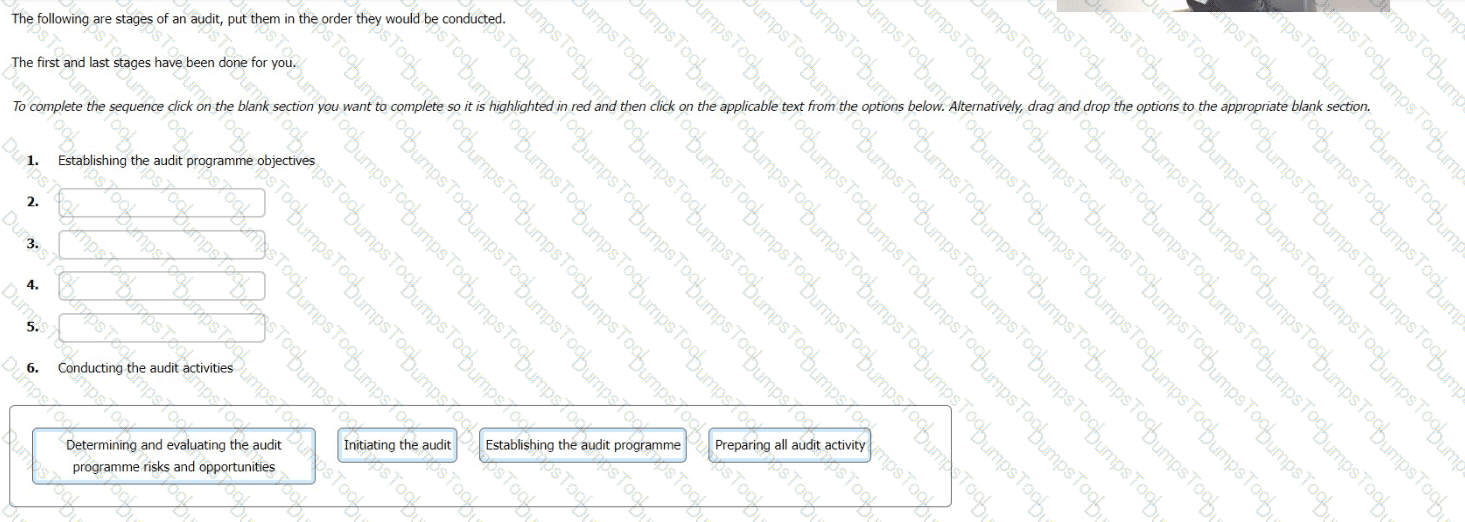
Which two of the following statements related to Stage 1 of an initial certification audit against ISO 9001:2015 are true?
Scenario 3:
Fin-Pro is a financial institution in Austria offering commercial banking, wealth management, and investment services. The company faced a significant loss of customers due to failing to improve service quality as they expanded.
To regain customer confidence, top management implemented a QMS based on ISO 9001. After a year, they contacted ACB, a local certification body, to pursue ISO 9001 certification.
The audit team was led by Emilia, an experienced lead auditor, and included three auditors. After an agreement was reached, ACB sent the audit objectives to the audit team.
The audit team began by gathering information about Fin-Pro’s understanding of ISO 9001 requirements. While reviewing documented information, they noticed missing records of training and awareness sessions. They conducted employee interviews to verify attendance.
The team also reviewed the organizational chart and job descriptions to confirm employee competence. They observed the company’s working environment (social, psychological, and physical conditions).
The audit team analyzed the evidence and prepared an audit report with findings and conclusions.
ACB sent the audit objectives to the audit team after an agreement was reached. Is this acceptable?
Scenario 3:
Fin-Pro is a financial institution in Austria offering commercial banking, wealth management, and investment services. The company faced a significant loss of customers due to failing to improve service quality as they expanded.
To regain customer confidence, top management implemented a QMS based on ISO 9001. After a year, they contacted ACB, a local certification body, to pursue ISO 9001 certification.
The audit team was led by Emilia, an experienced lead auditor, and included three auditors. After an agreement was reached, ACB sent the audit objectives to the audit team.
The audit team began by gathering information about Fin-Pro’s understanding of ISO 9001 requirements. While reviewing documented information, they noticed missing records of training and awareness sessions. They conducted employee interviews to verify attendance.
The team also reviewed the organizational chart and job descriptions to confirm employee competence. They observed the company’s working environment (social, psychological, and physical conditions).
The audit team analyzed the evidence and prepared an audit report with findings and conclusions.
In scenario 3, the audit team required access to see the organizational chart and job descriptions to verify the employees’ competence. Based on audit best practices, is this acceptable?
ABC is a worldwide fast-food organisation. One of the branches, in downtown Cape Town, decided to
implement an ISO 9001 quality management system and you are the audit team leader (with two other
auditors) that will carry out the certification audits, Stage 2.
ABC receive the orders by phone or internet; some of the employees deliver the ordered food to indicated
addresses. The normal menu includes 15 different types of hamburgers; however, in the last two weeks,
due to a shortage of a special type of meat, they can only prepare six of the 15 varieties.
During the internal meeting of the audit team, you ask one of the auditors to describe what she has
observed. She audited the reception of orders from customers (via phone or internet) and the
communication of the orders to the kitchen. She noticed that the menu offering food on the website is still
the normal one, with 15 different hamburgers, and during a 30-minute period, she observed many
customers reluctantly accepting something other than the hamburger they preferred.
You, as audit team leader, inform the Quality Manager of your concern about the major nonconformity,
since you consider this a serious breach of the basic principles of quality that lasted two weeks without
action being taken.
Right at the beginning of the Closing meeting, you discuss the nonconformity with the General Manager.
She got quite upset and said she was going to make a complaint to the certification body and left the
room; the Quality Manager was the only member of ABC left with the audit team. The Quality Manager said the General Manager would not come back to the meeting.
What would you do? Choose the best from the following options:
XYZ Corporation employs 100 people, and during a Stage 1 certification audit, certain issues are identified with the Quality Management System (QMS). Which two options describe the circumstances in which you could raise a nonconformity against Clause 6.2 of ISO 9001:2015?
In a third-party audit to ISO 9001, select two options of when the organisation is required to act in response to reported findings.
During a second-party audit, the auditor examines the records that are available for the external provider, ABC Forgings, to whom manufacturing has recently been outsourced.
There are standard external provider checklists for three competitors for the contract and there are inspection records from the trial manufacturing batches produced by ABC Forgings. There is no documented evidence of the criteria used to confirm the appointment of ABC Forgings, and no contract or terms and conditions. Ongoing monitoring indicates that external provider performance is satisfactory, but no documented information has been retained.
Select two options for the evidence which demonstrates a nonconformity with clause 8.4 of ISO 9001.
Scenario 4:
TD Advertising is a print management company based in Chicago. The company offers design services, digital printing, storage, and distribution. As TD expanded, its management recognized that success depended on adopting new technologies and improving quality.
To ensure customer satisfaction and quality improvement, the company decided to pursue ISO 9001 certification.
After implementing the QMS, TD hired a well-known certification body for an audit. Anne Key was appointed as the audit team leader. She received a document listing the audit team members, audit scope, criteria, duration, and audit engagement limits.
Anne reviewed the document and approved the audit mandate. The certification body and TD’s top management signed the certification agreement.
Before contacting TD, Anne reviewed the audit scope and noticed that TD made changes to it due to the adoption of new printing equipment. However, Anne disagreed with the changes, stating they would affect the audit timeline. She considered withdrawing from the audit.
How do you assess the situation presented in the last paragraph of scenario 4?
Which of the following subjects should an auditor discuss when communicating with the auditee’s top management?
Scenario 2:
Bell is a Canadian food manufacturing company that operates globally. Their main products include nuts, dried fruits, and confections. Bell has always prioritized product quality and has maintained a good reputation for many years. However, the company's production error rate increased significantly, leading to more customer complaints.
To increase efficiency and customer satisfaction, Bell implemented a Quality Management System (QMS) based on ISO 9001. The top management established a QMS implementation team comprising five middle managers from various departments, including Leslie, the quality manager.
Leslie was responsible for assigning responsibilities and authorities for QMS-related roles. He also suggested including a top management representative in the QMS team, but top management declined due to other priorities.
The team defined the QMS scope as:
"The scope of the QMS includes all activities related to food processing."
Leslie established a quality policy and presented it to the team for review before top management approval. Top management also proposed a new strategy for handling customer complaints, requiring biweekly customer surveys to monitor customer perceptions.
Which statement related to the last paragraph of scenario 2 is correct?
In the context of a management system audit, identify the sequence of a typical process for collecting and verifying information. The first one has been done for you.
To complete the sequence click on the blank section you want to complete so it is highlighted in red and then click on the applicable text from the options below. Alternatively, drag and drop the options to the appropriate blank section.
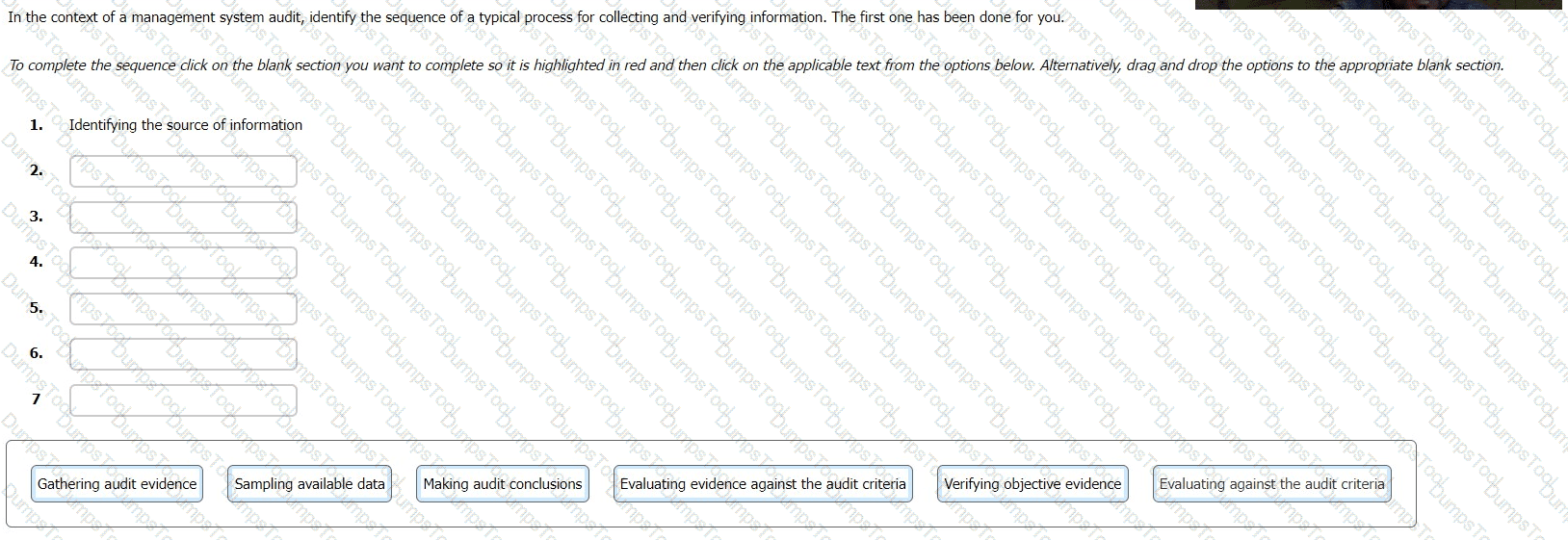
You are conducting an ISO 9001 audit of a Materials Recycling Facility (MRF). The organisation processes
waste plastics into raw materials for plastic bottle manufacturers. You reach the manual picking line where operators are removing contaminant materials from incoming products, such as plastic bags, plastic film and badly contaminated items that would compromise the recycling process. You interview the line supervisor.
You: "Why are these plastic items being rejected at this stage?"
Auditee: "They do not meet our processing standards."
You: "What is the reason for that?"
Auditee: "These items are likely to damage the machinery down the line. They can also compromise our
quality standards. We need to protect our reputation for good quality output materials."
You: "What happens to the rejected items?"
Auditee: "Some get melted down in another process later on and some are disposed of as waste products that cannot be recycled."
You: "What happens to the waste products?"
Auditee: "I'm not sure. I suppose they go to landfill."
Which two. of the following actions would you take to investigate further?
Scenario 6: Davis Clinic (DC) is an American medical center focused on integrated health care. Since its establishment DC was committed to providing qualitative services for its clients, which is the reason why the company decided to implement a quality management system (QMS) based on ISO 9001. After a year of having an active QMS in place, DC applied for a certification audit.
A team of five auditors, from a well-known certification body, was selected to conduct the audit. Eva was appointed as the audit team leader. After three days of auditing, the team gathered to review and examine their findings. They also discussed the audit findings with DC's top management and then drafted the audit conclusions.
In the closing meeting, which was held between the audit team and the top management of DC. Eva presented two nonconformities that were detected during the audit. Eva stated that the company did not retain documented information regarding its outsourced services for an analysis laboratory and regarding the conducted management reviews. During the closing meeting, the audit team required from DCs top management to come up with corrective action plans within two weeks. Although the top management did not agree with the audit findings, the audit team insisted that the auditee must submit corrective actions within the given time frame in order for the audit activities to continue.
Once the action plans were evaluated, the audit team began preparing the audit report. Eva required from the team to provide accurate descriptions of the audit findings and the audit conclusions. The report was then distributed to all the interested parties involved in the audit, including the certification body Based on the report, the certification body together with Eva, as the audit team leader, made the certification decision.
Based on the scenario above, answer the following question:
Is it acceptable for the certification body and Eva to make the certification decision together?
Which of the following is a record related to the audit program that should be managed and maintained?
In the context of a third-party certification audit, match the roles with the following responsibilities:
